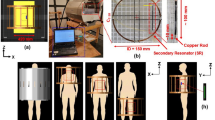Abstract
A comprehensive design methodology is proposed in this paper in order to optimise E-field probes used for evaluating the specific absorption ratio within liquid equivalent tissues exposed to radiofrequency signals. Hybrid analysis approaches are investigated, combining both electromagnetic (three dimensional) and circuit simulators. This design environment can therefore be considered for enhancing E-field detectors’ performances in terms of sensitivity, isotropy, dimensions and shape. Comparisons between simulations and measurements are presented and discussed.













Similar content being viewed by others
References
IEEE (2003) IEEE Standard 1528. Recommend practice for determining the peak spatial-average Specific Absorption Rate (SAR) in the human head from wireless communications devices: measurement techniques. IEEE, New York
CENELEC (2001) EN 50361: Norme de base relative à la mesure du Débit d’Absorption Spécifique relatif à l’exposition des personnes aux champs électromagnétiques émis par les téléphones mobiles (300MHz–3GHz). CENELEC, Brussels
Bassen HI (1983) Electric field probes—a review. IEEE Trans Antennas Propag 315:710–718 September
Kanda M (1993) Standard probes for electromagnetic field measurements. IEEE Trans Antennas Propag 41(10):1349–1364 October
Pokovic K, Nikoloski N, Christ A, Kuster, N (2005) Compliance Testing Tools and Procedures for Emerging Technologies (3–6 GHz). In: 18th International Conference on Applied Electromagnetic and Communications, 2005. ICE COM 2005. 12–14 Oct. 2005, pp 1–4
Hewlett Packard (1990) The criterion for the tangential sensitivity measurement—application note 956-1. Hewlett Packard, Palo Alto1 October
Hamid M, Hamid R (1997) Equivalent circuit of dipole antenna of arbitrary length. IEEE Trans Antennas Propag 45(11):1695–1696 November
Acknowledgement
This study lies within the scope of the National Network of Research in Telecommunications and corresponds to the Algorithms for Dynamic Optical Networks based on Internet Solutions Project (Dosimetric Analysis for the 3rd generation of mobile systems for telecommunications; www.tsi.enst.fr/adonis).
Author information
Authors and Affiliations
Corresponding author
Rights and permissions
About this article
Cite this article
Person, C., Le Pennec, F. & Luc, J. Design, modelisation and optimisation of high efficiency miniature E-field probes performed on 3D ceramic prisms for SAR evaluation. Ann. Telecommun. 63, 43–53 (2008). https://doi.org/10.1007/s12243-007-0004-3
Received:
Accepted:
Published:
Issue Date:
DOI: https://doi.org/10.1007/s12243-007-0004-3




